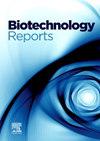聚磷酵母合成负载磷酸钴的生物炭及其电催化剂的应用。
Q1 Immunology and Microbiology
引用次数: 0
摘要
一种积累磷(P)的酿酒酵母突变株被用作过渡金属磷化物(TMPs)生物炭的前体。用四氢呋喃处理聚磷酵母,再加上热解,形成了负载二氧化碳的生物炭(CoP@P-yeast),这与之前报道的使用干面包酵母负载二氧化碳的生物炭不同。CoP@P-yeast在10 mA cm-2下的过电位为-192 mV,具有析氢电催化活性。在硝酸还原反应中,CoP@P-yeast的产氨率最高,为33 mg-NH3 h-1 mg-catalyst-1,远高于石墨化碳上铂的产氨率。扫描电镜和透射电镜观察发现,较大的TMP晶体主要位于生物炭表面,这可能有利于避免硝酸盐还原反应中的催化变质。本研究表明,积累磷的酵母菌突变株是提高TMP生物炭活性的合适前体。本文章由计算机程序翻译,如有差异,请以英文原文为准。
Cobalt phosphide-loaded biochar synthesis using phosphate-accumulating yeast and its application as an electrocatalyst
A phosphorus (P)-accumulating mutant strain of Saccharomyces cerevisiae is used as a precursor for transition metal phosphides (TMPs) biochar. Tetrahydrofuran treatment of the P-accumulating yeast coupled with pyrolysis resulted in the formation of CoP-loaded biochar (CoP@P-yeast) unlike previously reported Co2P-loaded biochar using dry baker's yeast. The CoP@P-yeast exhibited the electrocatalytic activity for the hydrogen evolution with an overpotential of −192 mV at 10 mA cm−2. Furthermore, the CoP@P-yeast showed the highest ammonia production rate of 33 mg-NH3 h−1 mg-catalyst−1 in nitrate reduction reaction, as well as much higher than that with platinum on graphitized carbon. Scanning electron microscopy and transmission electron microscopy observations revealed that relatively large TMP crystals mainly located at the biochar surface, which may be beneficial to avoid catalytic deterioration during the nitrate reduction reaction. This study demonstrates that P-accumulating mutant strain of yeast is a suitable precursor to improve the activity of the resulting TMP biochar.
求助全文
通过发布文献求助,成功后即可免费获取论文全文。
去求助
来源期刊

Biotechnology Reports
Immunology and Microbiology-Applied Microbiology and Biotechnology
CiteScore
15.80
自引率
0.00%
发文量
79
审稿时长
55 days
期刊介绍:
Biotechnology Reports covers all aspects of Biotechnology particularly those reports that are useful and informative and that will be of value to other researchers in related fields. Biotechnology Reports loves ground breaking science, but will also accept good science that can be of use to the biotechnology community. The journal maintains a high quality peer review where submissions are considered on the basis of scientific validity and technical quality. Acceptable paper types are research articles (short or full communications), methods, mini-reviews, and commentaries in the following areas: Healthcare and pharmaceutical biotechnology Agricultural and food biotechnology Environmental biotechnology Molecular biology, cell and tissue engineering and synthetic biology Industrial biotechnology, biofuels and bioenergy Nanobiotechnology Bioinformatics & systems biology New processes and products in biotechnology, bioprocess engineering.
 求助内容:
求助内容: 应助结果提醒方式:
应助结果提醒方式:


